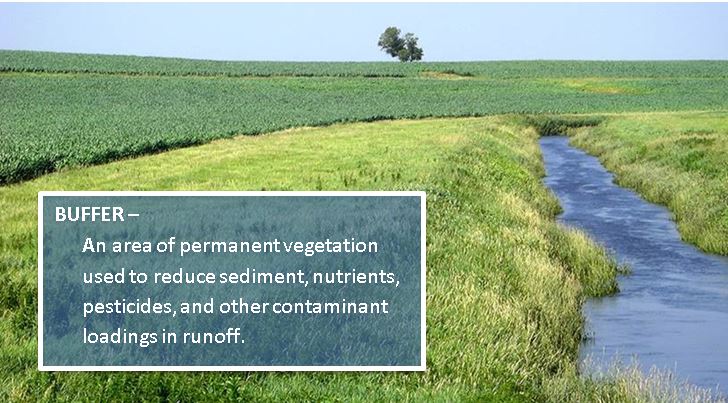 When everything else fails there’s always the “last ditch effort.” By definition, the last ditch effort is never the first choice. Instead, it is reserved as the last choice. In my opinion, buffer strips should be seen as the last ditch effort. Why? Because it is our last chance to filter sediment and nutrients out of the water before they leave the farm. While this may be good for downstream water quality, it doesn’t do much to help the farm itself. We need to rely more on in-field conservation practices and less on edge of field practices. Instead of a primary practice, buffer strips should be seen as the last line of defense. Buffer strips should not be our “go-to” practice. They should be our backup practice. We should encourage landowners to consider in-field conservation to keep the soil and crop nutrients where they belong — growing the crop.
When everything else fails there’s always the “last ditch effort.” By definition, the last ditch effort is never the first choice. Instead, it is reserved as the last choice. In my opinion, buffer strips should be seen as the last ditch effort. Why? Because it is our last chance to filter sediment and nutrients out of the water before they leave the farm. While this may be good for downstream water quality, it doesn’t do much to help the farm itself. We need to rely more on in-field conservation practices and less on edge of field practices. Instead of a primary practice, buffer strips should be seen as the last line of defense. Buffer strips should not be our “go-to” practice. They should be our backup practice. We should encourage landowners to consider in-field conservation to keep the soil and crop nutrients where they belong — growing the crop.
My top 3 reasons why buffer strips should be the last ditch effort:
Reason #3: Treating buffer strips as a priority practice sends the signal to farmers that conservationists are giving up on in-field soil erosion and nutrient runoff. It makes it seem like we are only focused on trapping sediment and nutrients just before they enter our streams and rivers. Instead we should consider other in-field best management practices (BMPs) long before we settle on buffer strips. Buffer strips should be the second or third line of defense — only used to catch what has slipped through other BMPs.
Reason #2: Buffer strips do nothing to improve soil health, except for the soil underneath the buffer strip. The very, very first step to improving soil health is soil conservation. After all, we cannot have healthy soils if we can’t minimize erosion. This means we have to get our soil loss under 1 ton/acre/year. You may hear tolerable soil loss level (“T” value) defined as 5 tons/acre/year. This is not tolerable for soil health. In fact, it is about 20 times higher than soil regeneration. We cannot lose our best soil (the topsoil and organic matter) and improve soil health. When we achieve soil erosion below 1 ton/acre/year, we not only improve soil health, but we also have far less sediment to trap in buffer strips.
Reason #1: We already have enough phosphorus in our floodplains. Research indicates that sediment with high phosphorus levels has built up on our floodplains from years of upland erosion. In some cases, phosphorus levels in floodplain soils are double that in adjacent uplands. These high phosphorus levels, combined with increased in-channel scouring and streambank erosion, result in a significant contribution of the phosphorus entering our streams and rivers. Using buffer strips as the first line of defense to trap even more sediment only aggravates this problem. It is a short term solution.
Wow, this makes it sound like I think buffer strips are a worthless practice. Not true. Buffer strips are a solid conservation practice that must be utilized. However, we need to understand that buffer strips only trap soil after it has moved downslope. Conservationists must help farmers prioritize those practices that keep soil in its place. But in order to do this, conservationists need tools that can quickly evaluate the efficacy and cost effectiveness of conservation practices. In other words, conservationists need precision conservation tools that are quick and easy.
Without these tools we will continue to allow eroded soil to be transported downstream and be deposited in our floodplain, only to be resuspended at another time with channel and streambank erosion.
 What the hell am I doing here?
What the hell am I doing here?
Amen!! Our emphasis needs to be on keeping the soil in place, not corralling it after it has moved out of the productive area. The best way to keep the soil in place is to keep all raindrops (and snowflakes) in place where they hit. If water moves vertically into the soil instead of horizontally across it, we don’t really need buffer strips or terraces.
The challenge is to develop a farming system that likely includes no-till, cover crops, and crop rotation to reduce soil erosion to nearly zero. We’re not there yet for the general farming population, but individual farmers HAVE reached this ultimate environmental goal while reaching crop yield and economic goals.
Thanks Randall,
I agree we need no-till, cover crops, and crop rotations. These are essential practices. That said, there is a place and a need for all conservation practices. We need grassed waterways, terraces, and sediment basins to control ephemeral erosion. We need ponds and wetlands to slow runoff and modify stream hydrology. We need contour grass strips for those farmers with hay/grass in their rotation. We need both management practices and structural practices. Management practices are more cost effective but structural practices are more permanent. And in many cases we will need limited filter strips along streams to corral the remaining nutrients from runoff.